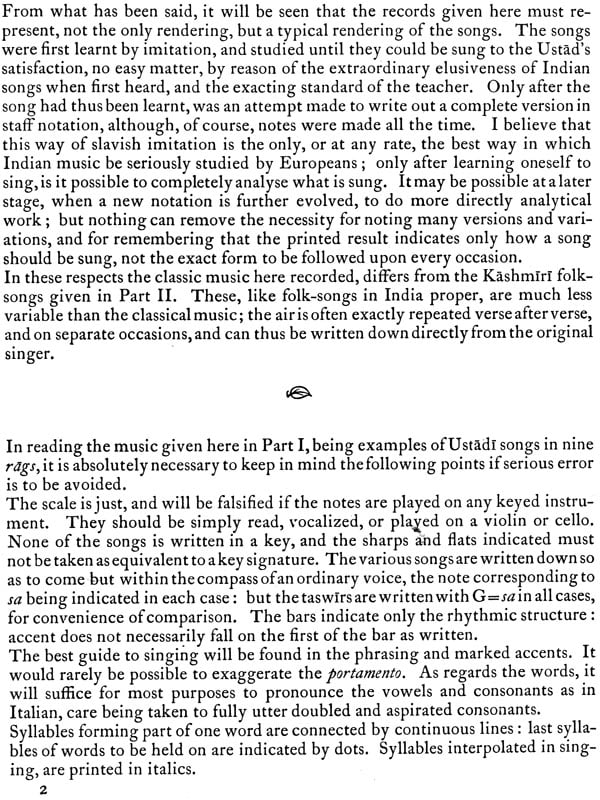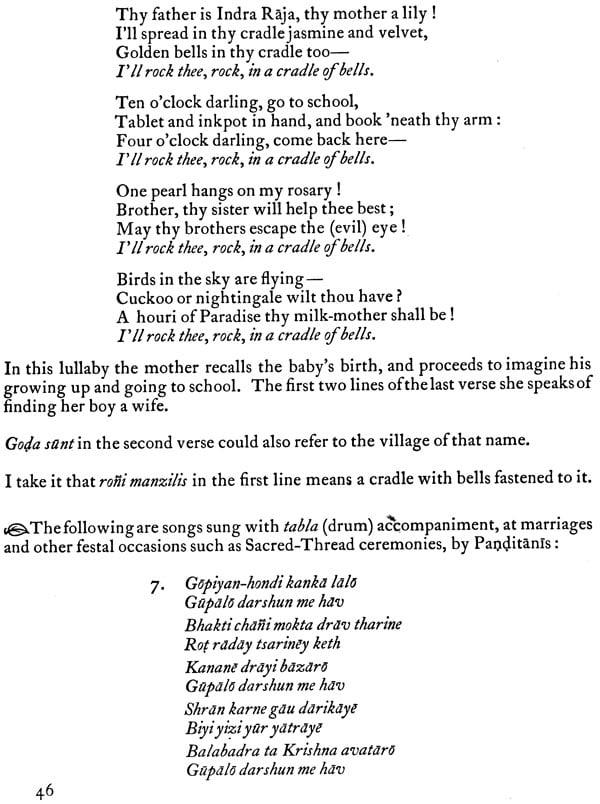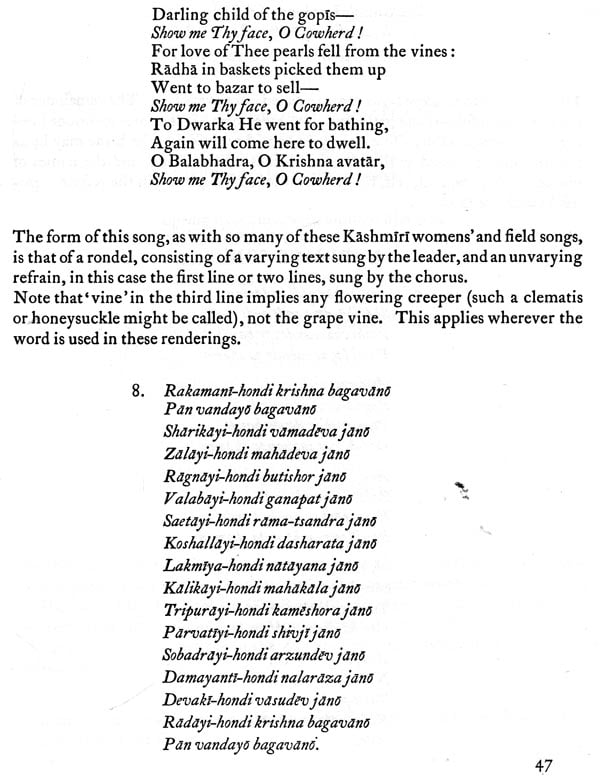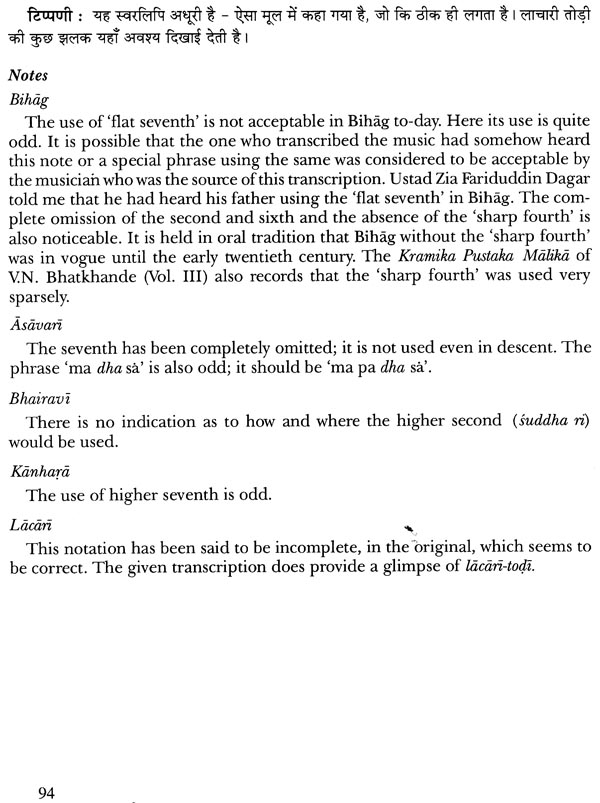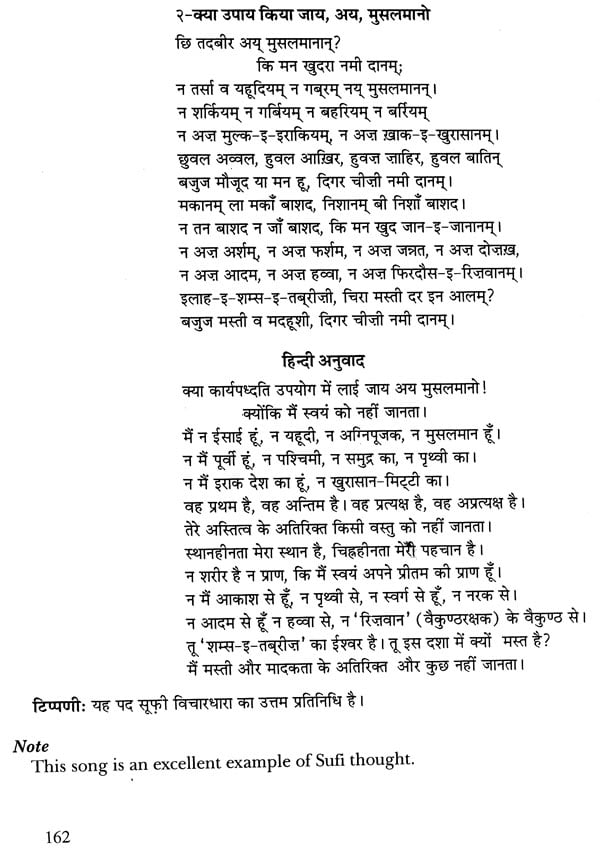
Thirty Songs from the Panjab and Kashmir (With Notation)
Book Specification
| Item Code: | NAP952 |
| Author: | Prem Lata Sharma |
| Publisher: | INDIRA GANDHI NATIONAL CENTRE FOR ARTS |
| Language: | English and Hindi |
| Edition: | 1994 |
| ISBN: | 8120716639 |
| Pages: | 191 |
| Cover: | HARDCOVER |
| Other Details | 11.00 X 9.00 inch |
| Weight | 900 gm |
Book Description
THIRTY SONGS FROM THE PANJAB AND KASHMIR is the eighth in the series of the Col- lected Works of Ananda K. Coomaraswamy in the IGNCA's publication programme. It was originally published by Luzac and Novello, in London in 1913. The songs were recorded by Mrs. Alice Coomaraswamy, who used the Indian name Ratan Devi professionally, with Introduction and translation by Ananda Coomaraswamy, and a Foreword by Rabindranath Tagore.
The Coomaraswamys stayed in a houseboat in Srinagar (Kashmir) in 1911, along with Ratan Devi's guru, Usaid Abdul Rahim of Kapurthala. There she studied and did riyaz under the guidance of her ustod. She later transcribed with mu- sic and words some of the songs - both classical and folk - she had learnt. The thirty songs documented by her in staff notation are compositions of genres like Dhrupad, Khayal, Thumri, Dadra, etc. as well as folk songs in Panjabi, Dogri, Kashmiri etc; also sufi songs in Urdu, Persian and Kashmiri. The present volume reproduces the above compilation as Part I, and Part A contains a transcription of the staff notation into Sarigama notation in Devanagari, a Hindi translation of the non- Hindi texts of songs and notes in Hindi and English on raga, tala, and text. Prof. Prem Lata Sharma, an eminent musicologist, has very painstakingly prepared the text of Part A. The value of this volume lies in its great historical importance and vast expanse of musical genres brought under one fold by the great visionary that Coomaraswamy was. His prophetic remark - "Indian music is the most significant of surviving Indian arts; if it dies, it will be of starvation rather than of inherent weakness. It has been, perhaps, the greatest aesthetic achievement of Indian civilisation, the art in which that civilisation has most perfectly expressed itself", deserves serious attention.
It is hoped that students of Indian music and its history will benefit immensely and use this edition to their interest and profit.
Prof. Prem Lata Sharma, a distinguished scholar of Musicology, Sanskrit and Hindi, secured Doctorate in Sanskrit from the Banaras Hindu University. Having received advanced training in vocal music from the illustrious Pandit Omkar Nath Thakur, she started her career as teacher of music, its theory, history and philosophy, and held the post of Professor and Head of the Department of Musicology at the Banaras Hindu University. She was the Chairman of U.P. Sangita Nataka Akademi, Lucknow (1983-86), and Vice- Chancellor of the Indira Kala Sangita Vishwavidyalaya, Khairagarh (M.P.), (1985-88). She was selected as Fellow of the Sangeet Natak Akademi, New Delhi, in 1992.
Author of several books, including the critical edition of Rasavilasa (1952), Sangitaraja (1963), Sahasarsa (1972), Ekalingamahatmysa (1976), Brhaddesi Vol. I and A (1992, 1994). She also translated many notable works in Hindi from Bengali; supervised the English translation of Sangita Ratnkara (two volumes of which have al- ready been published). She is at present working on a critical edition of 'Nanyadeva's Bharata-Bhasya and the chapters of Natyasastra dealing with music. She is also preparing a comprehensive glossary of technical terms of music and dance occurring in the important texts on Sangitasastra: Prof. Sharma is widely acclaimed as a poineer in initiating and establishing serious study of primary (Sanskrit) sources on Indian music.
FOREWORD Amongst Ananda Coomaraswamy's several early callings was Indian music. He was amongst the very few who endeavoured to look at this art as a major contribution to the world heritage. His fascination and admiration was so great that he did not hesitate to present, in early decades of the 20th century, its basic structures to the Western audiences. He married Alice Richardson, whom he had met at a recital given by the pupils of Cecil Sharp, a musician and writer engaged in the revival of English folk songs, in London in about 1910. Alice and Ananda Coomaraswamy travelled to India in 1911 and settled in a houseboat at Srinagar in Kashmir, Ustad Abdul Rahim of Kapurthala stayed with them in Srinagar for about ten weeks and Mrs. Alice Coomaraswamy became his Sisya in the traditional Guru-Sisya Parampara, with all due solemnity and offerings.
She now used the Indian name Ratan Devi professionally and studied and did riyaz under the Ustad daily. The songs were first learnt by repetition, and studied until they could be sung to the Ustad's satisfaction, which was according to Coomaraswamy, no easy matter, by reason of the extraordinary elusiveness of Indian songs when first heard, "and the exacting standard of the teacher. Only after the song had been thus learnt, was an attempt made out by Ratan Devi to write out a complete version in staff notation, although, of course, notes were made all the time. With her exceptional native talent, she learnt Indian classical music with extraordinary facility. She later transcribed with music and words some of the songs she had learnt, which Coomaraswamy translated into English and were brought out in the book Thirty Songs from the Panjab and Kashmir in 1913. While Coomaraswamy wrote an elaborate Introduction, the Foreword was contributed by Rabindranath Tagore.
Coomaraswamy's Introduction contains his observations on the nature of raga, explaining how raga is different from a scale, how it is a "melody-mould" or "musical pattern". His description of folk and classical songs whom he calls art songs, is very apt and brings out the basic point that the latter are characterised by a vast scope for 'variation', known as improvisation today. His deep appreciation of alap rendered by the Ustad as "an experience never to be forgotten" is telling. His description of gestures of Indian musicians as "the transference of one's own physical sensation into the form of a work of art", bears evidence to his sensitivity. So also his remark that "not carried to excess, this form of musical gesture gives an additional expressiveness to song - suggesting and conveying a self surrender to the rhythm and melody, which a wooden stillness would negative", illustrates his deep understanding of Indian music. His description of the liberal attitude of musicians like Ustad Abdul Rahim is very significant - "Abdul Rahim's faith in Hindu Gods is as strong as his belief in Islam and Moslem saints, and he sings with equal earnestness of Krishna or Allah, exemplifying the complete fusion of Hindu and Moslem tradition characteristic of so many parts of northern India". The vast range of the repertoire of the Ustad though given in nine ragas as examples in the book, covered various dialects and languages: Panjabi, Urdu, Dogn, Hindi, Sindi, Persian, Arabic.
The Coomaraswamys returned to England in 1912 and in the next few years, Ratan Devi gave recitals of Indian music not only in various places in England but when they went to America in early 1916, it was for a concert tour. Her recitals won the praise of not only English music critics, but Indian connoisseurs, including Rabindranath Tagore as well. He heard her in London and found himself passing from uneasy anticipation to complete delight in her mastery of all the technical difficulties of Indian song, which she combined with a voice far superior in quality and training to that of most Indian singers. Her rendering of Behag, Kandra and Malkaus, was sung with all their richness in details, depth of modulations and exquisite feeling. Listening to her, he felt "more clearly than ever that our music is the music of cosmic emotion".
George Bernard Shaw, who began his writing career as a music critic, remarked, "I have read most of the descriptions of Indian Music, with their attempts to convey some notion of it by our staff notation, but I never knew what it sounds like until I heard Mrs. Coomaraswamy sing to the accompaniment of an instrument which gives only the concord of the perfect fifth, singing not only the intervals of our own music in perfect tune, but the intervals of a much more subtly divided scale than ours is not only technically interesting, but most refreshing and enchantingly artistic". The tribute paid by William Butler Yeats was in his inimical poetic style, "Mrs. Coomaraswamy's singing delighted me. It was though as a moment of life had caught fire, an emotion had come to a sudden casual perfection".
We present here a faithful reproduction of the Original Edition as Part I, we have left the old spellings intact and have not even corrected a few obvious mistakes. Prof. Prem Lata Sharma, an eminent musicologist, has prepared Part A by transcribing the music from staff notation to sarigama notation in Devanagari, providing Hindi translation of song-texts couched in languages other than Hindi. Besides, she has given notes on the raga, tala, and text of songs wherever necessary in order to make the work contemporary. She has also contributed a detailed learned Introduction to this compilation. The IGNCA is indebted to her for having undertaken this task.
Dr. Rama P. Coomaraswamy has, as always, given encouragement and material support, even going to the extent of graciously lending us an uncut original copy of the limited First Edition from his father's archives. I would also like to record special thanks and deep appreciation to my colleague, Dr. Lalit M. Gujral, for his dedication in coordinating, arranging and supervising all publication details of this book.
Lastly, I sincerely thank Mr. Arun Mehta and Ms. Katey Cooper at Vakil and Sons, Bombay, for their high quality of printing and production of the book.
**Book's Sample Pages**

